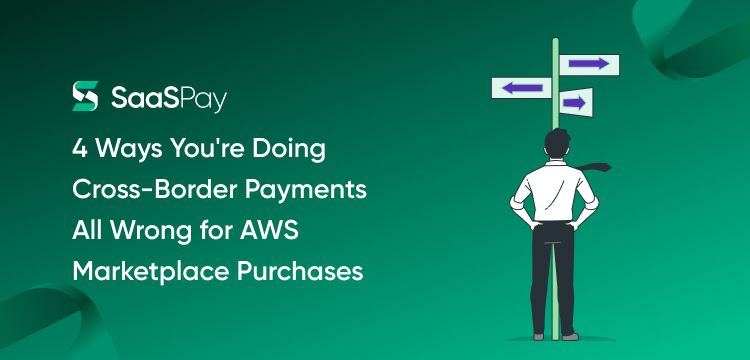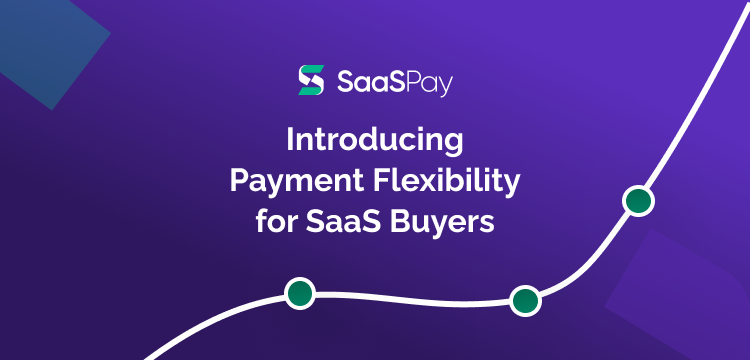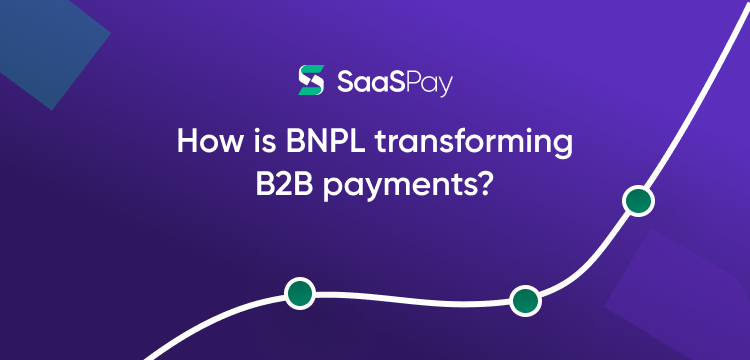
4 Ways You're Doing Cross-Border Payments All Wrong for AWS Marketplace Purchases
4 Ways You're Doing Cross-Border Payments All Wrong for AWS Marketplace PurchasesNavigating the complex realm of cross-border payments within the AWS Marketplace often feels like embarking on an odyssey fraught with hidden challenges. Here's where you maybe doing it wrong.
In this blog, we deep into the intricacies of traditional payment methods, uncovering the pitfalls that businesses unwittingly stumble into. The spotlight is on a common yet overlooked predicament—every AWS Marketplace transaction is confined to USD, a condition that exerts added pressure on non-US-based customers.
Picture this: navigating a vast marketplace, but every deal is tied to one currency. The result? Unexpected costs and inefficiencies that turn a seemingly simple transaction into a complex maze.
Our mission here is to shine a light on these financial intricacies and to be your compass in the sea of cross-border transactions. Join us as we uncover the missteps businesses often take, dig into the complexities of AWS Marketplace payments, and present a solution that promises simplicity, cost-effectiveness, and a smoother voyage in the dynamic world of tech transactions. Welcome to a journey where every payment aligns with your growth vision.
Common Missteps in Cross-Border Payments
It's easy to get cross-border payments wrong, often leading to unforeseen challenges that businesses grapple with.
High Withholding Taxes:
One of the significant misfortunes lies in the realm of withholding taxes levied on software purchases. Buyers based outside of US territory often find themselves subject to substantial withholding taxes ranging from 15% to 20%. Look at this tax as a toll booth on your payment highway, where a hefty percentage is deducted at the source before the funds even reach the destination.
Inconvenience of USD Payments:
The inconvenience of completing transactions in USD poses another substantial challenge. For non-US buyers, the complications multiply with add-ons like currency conversion fees, an unwelcome companion on the journey. These currency conversion fees add up to become an unforeseen expense that secretly nibbles away at your budget.
Lack of Visibility:
Traditional cross-border payment methods like wire transfers, credit card transactions, electronic funds transfers, and money orders lack centralized visibility, leaving buyers in the dark regarding the present status and movement of their transactions. It's akin to navigating a vast sea without a compass, leading to confusion and uncertainty about payment details and status. The absence of a streamlined process leaves businesses exposed to the risk of miscalculations and financial turbulence.
Current Industry Trends in Cross-Border Payments on AWS Marketplace
Within the intricate web of cross-border transactions, businesses often resort to prevailing industry practices, hoping to navigate the complexities of international dealings. However, these practices, though prevalent, might not always be the most efficient or cost-effective for buyers in the AWS Marketplace.
Over-reliance on Traditional Banking Channels:
Businesses often entrust their funds to the traditional banking system, assuming it to be a safe and reliable way to make cross-border payments on AWS Marketplace. However, this reliance can prove to be a double-edged sword. Traditional banks follow complex processes and a bureaucratic approach, which can lead to delays and unexpected costs. It's like choosing a well-traveled route, only to find yourself stuck in a traffic jam with unforeseen toll booths.
Opaque Fee Structures:
Another prevalent industry practice is the acceptance of opaque fee structures, unsure about the breakdown of charges levied by the payment facilitator. This lack of transparency can lead to businesses unknowingly facing significant costs.
Fragmented Payment Processes:
Industry norms often accommodate fragmented payment processes, leading to operational inefficiencies. This fragmentation arises from the disconnected nature of traditional payment systems. The lack of cohesion in cross-border payment processes can lead to confusion, delays, and additional administrative burdens for businesses.
Unawareness of Alternative Solutions:
A prevailing issue in the industry is the lack of awareness regarding alternative solutions. Many businesses, trapped in the familiarity of existing methods, might not be exploring more modern, efficient alternatives. Unawareness often leads to missed opportunities for improved efficiency and cost savings.
The SaaSPay Advantage
Forgo Withholding Taxes with SaaSPay
One of the revolutionary advantages SaaSPay brings to the table is the elimination of withholding taxes. Through strategic partnerships with RBI-compliant Forex experts and AD1 banks, SaaSPay ensures that buyers can navigate the complex landscape of withholding taxes seamlessly. Buyers can now experience a significant reduction in expenses, with 15-20% withholding taxes becoming a thing of the past.
Local Currency Payments:
SaaSPay redefines the cross-border payment experience by allowing payments in INR and other local currencies. By doing away with the need to pay in USD businesses save on the currency conversion fees. With SaaSPay, businesses can streamline their payment processes, making them more cost-effective and straightforward.
Visibility into the Payment Progression
A key element in the SaaSPay advantage is the provision of a centralized dashboard. This dashboard serves as a control tower, offering real-time data flow and complete visibility into payment details and status. It's like having a cockpit view of your AWS Marketplace USD Payments. With this transparency, businesses can make informed decisions, track their expenses, and ensure that their financial flight is on the right trajectory, while they pay in INR.
In essence, the SaaSPay Advantage is not just about fixing the flaws in traditional cross-border payment methods; it's about providing a superior, more efficient, and transparent experience.
Understanding the SaaSPay Process
The journey begins with the order placement on AWS Marketplace, where businesses initiate their tech purchases. As the order progresses through the various stages, SaaSPay seamlessly integrates into the process, ensuring that each step aligns with the buyer's financial strategy. This is analogous to a well-choreographed dance, where each move contributes to the overall harmony of the transaction.
1. The buyer receives an invoice in USD for their purchase from the Accounts Receivables team of AWS Marketplace.
2. Upon receiving the invoice, the buyer opts to make the payment in Indian Rupees (INR) and shares the AWS MP invoice with SaaSPay.
3. SaaSPay responds by creating an INR payment order, corresponding to the USD invoice value.
4. The buyer is instructed to transfer the specified INR amount to a designated virtual account linked to AWS Marketplace.
5. After receiving the INR payment, SaaSPay collaborates with its banking partners to convert and transfer the amount to AWS MP’s US account. This transfer utilizes SWIFT codes for international transaction processing.
6. Following the successful transfer and reconciliation of payment, AWS Marketplace issues a Tax Residency Certificate to the buyer within 1-2 days. This certificate is crucial for the buyer to remain compliant with government tax regulations during the filing process.
Role of FX Partners and AD1 Banks:
In the realm of cross-border payments, SaaSPay's partnership with Forex experts and AD1 banks is the bedrock of trust. Acting as the conductors of our financial orchestra, these entities ensure seamless fund movement, tax management, and payment processing. Our collaboration with RBI-compliant Forex experts is strategic, guaranteeing businesses a smooth journey through the intricate regulatory landscape. This affiliation underscores our commitment to transparency, security, and regulatory compliance, instilling confidence in users that their transactions are in expert hands. With SaaSPay, businesses gain access to a network of trusted partners, ensuring reliability and integrity in every cross-border transaction.
Let’s dive into the real-world implications of embracing SaaSPay for AWS Marketplace purchases. These case studies and hypothetical scenarios are not just theoretical; they represent tangible transformations that businesses can achieve.
Unlocking Savings for a Leading Tech Firm:
SaaSPay's multicurrency solution unlocked substantial savings for a leading tech giant with diverse global operations. Before SaaSPay, their AWS purchases incurred hefty withholding taxes, impacting their bottom line. With our solution, they bypassed these taxes, significantly enhancing profitability and optimizing their global financial operations.
This cost-effective approach is a hallmark of the SaaSPay process, charging a nominal transaction cost of 1.5%. In a landscape where each percentage point matters, this transparent fee structure empowers businesses to maximize value, standing in stark contrast to traditional cross-border methods with hefty fees.
SMEs Driving Efficiency with Local Currency Payments:
Small and medium enterprises (SMEs) often grapple with the complexities of cross-border transactions. SaaSPay's multicurrency product proved to be a game-changer for an emerging tech startup. By facilitating payments in INR, the local currency, they eliminated currency conversion fees and simplified their financial workflows. This not only reduced operational costs but also enhanced the overall efficiency of their financial transactions.
Enhancing Transparency on any platform:
For any platform heavily reliant on AWS services, transparency in financial transactions is paramount. SaaSPay's centralized dashboard provided real-time data flow and visibility, allowing the platform to track and manage their AWS expenses effortlessly. This newfound transparency not only streamlined their financial reporting but also empowered them to make data-driven decisions, optimizing their AWS spending.
Conclusion
As we wrap up this journey, we reflect on the missteps, prevailing industry practices, and the transformative SaaSPay advantage that promises a simpler, cost-effective voyage in the dynamic world of tech transactions. In conclusion, SaaSPay's MultiCurrency product emerges not just as a solution but as a catalyst for positive change in the cross-border payment landscape. As we embark on the future of tech transactions, SaaSPay stands as a beacon, guiding businesses toward simplicity, cost-effectiveness, and success.
Join us in redefining the rules of cross-border payments—where every transaction aligns seamlessly with your global vision.

SaaSPay for Buyers


Why BNPL for SaaS?


How is BNPL transforming B2B payments?
